How to Visit Ollantaytambo Ruins in Peru? Planning your Day Trip

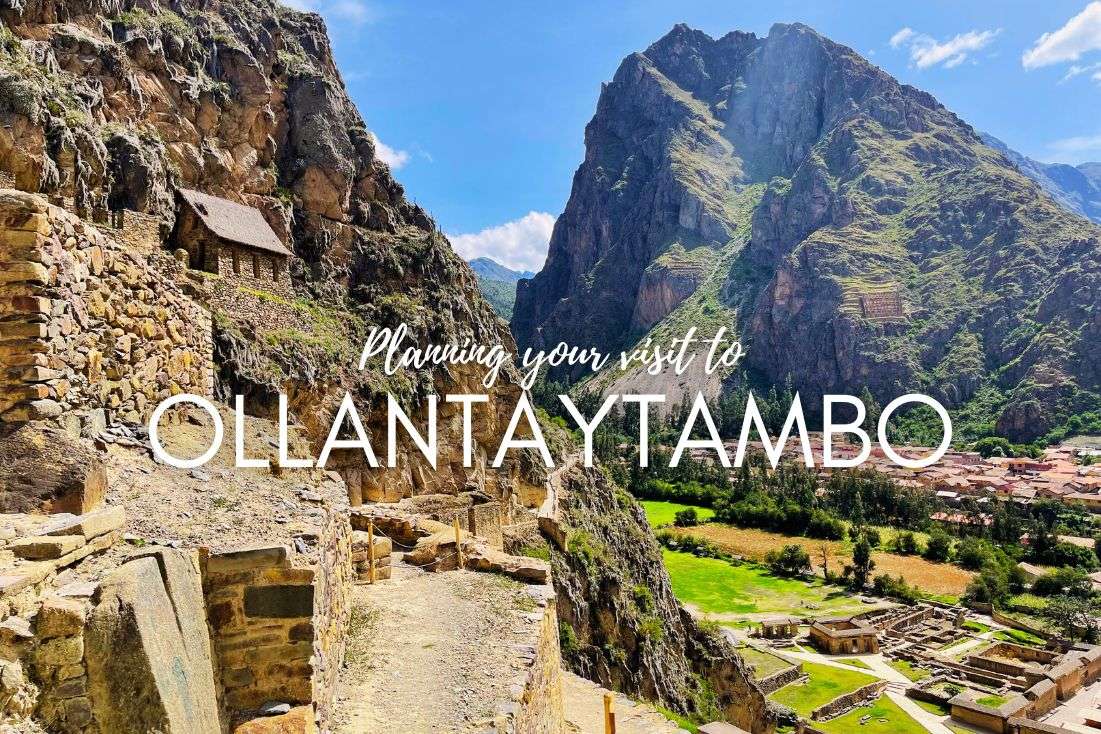
Ollantaytambo is just a blip on the radar for some while it gets remembered by others as the best views in Peru. How’s this possible?
The first group are just boarding a train to Machu Picchu with their faces buried in their phones; the second group takes time to appreciate Ollantaytambo, either by setting out on the Inca Trail from there, or at least taking a day trip form Cusco to check out the ruins.
Ollantaytambo is one of the most significant archaeological complexes in South America, offering a glimpse into the rich history and culture of the Inca Empire (and teaches you plenty about the Spanish invasion!).
The Inca ruins at Ollantaytambo are huge. This used to be a full-on city and strategic military outpost, guarding Sacred Valley from the west, while Pisac protects it on the east side. When the Spanish arrived, Ollantaytambo’s strategic location helped it resist their forces for a time.
The ruins copy the mountainous terrain and are perched up above the town of Ollantaytambo down in the valley, which is where the train to Aguas Calientes (also known as Machu Picchu Pueblo) leaves from. Ollantaytambo is also a common starting point of the Inca Trail.
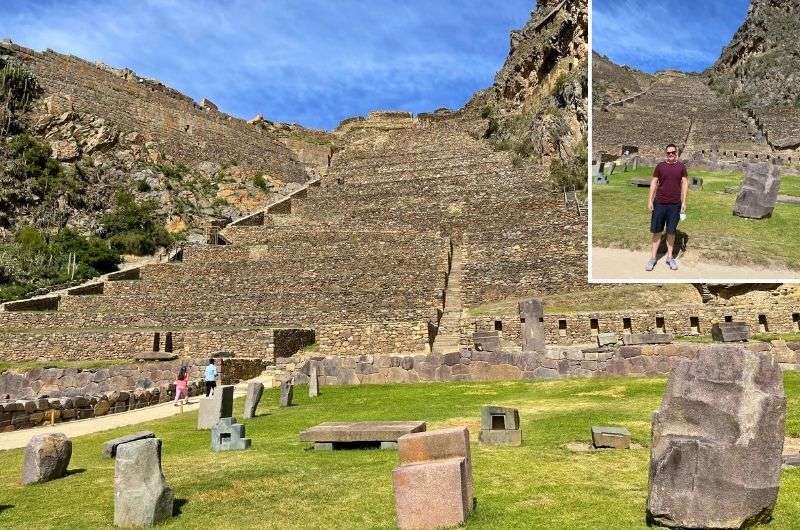
Ollantaytambo is an amazing archeological site which deserves its own article
So what should you know before you visit Ollantaytambo Peru?
My top tips for visiting Ollantaytambo:
- Spend a day: First of all, don’t skip it! Ollantaytambo has great ruins and absolutely incredible Sacred Valley views! Spend a few hours or even a whole day here before heading to Machu Picchu from Ollantaytambo’s train station.
- Getting to Ollantaytambo: We drove the 1.5 hours from Cusco in our rental car and I’d recommend this to everyone for ultimate flexibility. There’s also a train from Cusco.
- Tickets: You’ll need the Cusco Tourist Ticket to visit Ollantaytambo ruins. Choose circuit 3 for PEN 70 (USD 13), or the complete circuit that includes just about every tourist attraction in Sacred Valley and Cusco. More Cusco Tourist Ticket information in my Sacred Valley article.
- You don’t need a tour: The ruins are easily visited as a self-guided tour. You’ll need about 2 hours to walk the 2 km (1.2 mi) trail. It’s steep, but the views of the archaeological site and the surrounding valley are worth it!
- Surprising viewpoints: Take in the views from the other side of town from the viewpoint called Pinkuylluna. It’s even better to see views of the ruins when you aren’t actually standing in the middle of them.
- Hotels in Ollantaytambo are slightly frustrating: With the number of tourists flowing in, hotels in Ollantaytambo are generally not great value for money. There are no 4-star hotels in the town, so try the 3-star El Albergue Ollantaytambo—a little gem right by the train station. For a little more luxury, you’ll need to head to Urubamba.
1. The legendary history of Ollantaytambo and Manco Inca
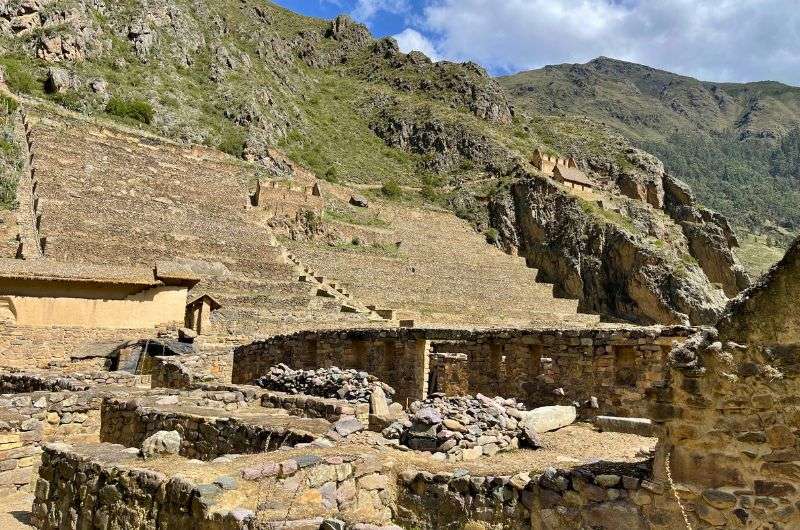
Ollantaytambo was a key defensive point, especially when Manco Inca led the fight against Spanish invaders from this stronghold
Ollantaytambo’s history is like a blockbuster epic that dates back to the 15th century. Originally conquered by Inca Emperor Pachacuti, it became his royal estate where Inca nobility resided, complete with jaw-dropping stone structures like the Sun Temple. But the real action started when the Spanish arrived, and Manco Inca, the hero of Inca resistance, used Ollantaytambo as a fortress against the Spanish conquerors. He even sent Hernando Pizarro packing after a fierce battle—though the Spanish eventually got the upper hand. Today, this UNESCO site still echoes with tales of resilience and glory!
2. Are the ruins at Ollantaytambo worth visiting?
Oh, 100%! The Ollantaytambo ruins are worth visiting. You’ll be walking through an ancient Inca fortress where you can practically feel the history oozing from every stone. There’s the jaw-dropping Sun Temple and the massive terraces with killer views of the Sacred Valley—it’s a site that’ll leave you in awe. And even if you’re not a history buff, the epic views alone are reason enough to go. Plus, it’s on your way to Machu Picchu, so why not?
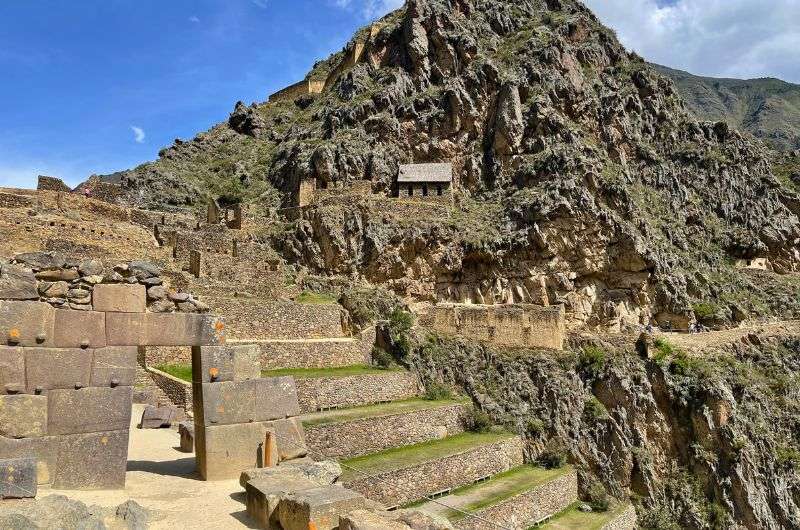
Agricultural terraces of Ollantaytambo ruins
3. A self-guided visit to Ollantaytambo ruins: How to do it
You can easily explore the archaeological site of Ollantaytambo on your own. It’s only a 5-minute walk from the Plaza de Armas to the entrance.
A quick guide to exploring the Ollantaytambo ruins:
-
Starting point: To enter Ollantaytambo ruins, it’s a 5-minute walk from Plaza de Armas. If arriving from the train station, it’s a 20-minute uphill walk (tuk-tuk are available for about PEN 5).
- Main attractions: Climb the 17 terraces, explore the Sun Temple and the Wall of Ten Niches, and don’t miss the Pre-Inca Sector, and the views of Valley of the Incas are out of this world.
- Main trail length: It’s about 2 km (1.2 miles) to walk between all the main highlights of the ruins.
- Time spent there: I wandered around for a good 2 hours at the Inca ruins. The trail isn’t super long, but there’s so much interesting stuff to see!
- Facilities: Restrooms available at the entrance.
Alltrails has a map of the best route at the Ollantaytambo ruins, though it’s pretty impossible to get lost there
At the Ollantaytambo ruins you can see the urban organization of the former Inca city, including the walls of the fortress, water channels and fountains (still functional!), quarries and storehouses. You’ll also notice that the Incas built agricultural terraces that were used for growing crops that would’ve otherwise not grown at this altitude, similar to the system at Moray, another cool Inca site not far away.
Start by climbing the 17 terraces that dominate the site, taking in the stunning views of town of Ollantaytambo and Sacred Valley as you go. Highlights include the Sun Temple, with its colossal pink granite stones, the Wall of 10 Niches, and the Pre-Inca Sector.
Take your time walking the terraces and stop to admire the intricate Inca stonework; keep an eye out for significant Inca symbols, including the Andean cross (Chakana). Don't forget to explore the Water Temple and ceremonial fountains near the exit!
It’s fascinating stuff, because the Incas were fascinating people. They were no doubt intelligent, and, just because I want to, I’m going to assume they had a great sense of humor. Like me. Heck, they even taxed citizens based on how happy they were. Not happy enough, here, lower taxes for you! Better? I’m sure the Incas would’ve made great beer buddies.
The mystery of the Wall of the Six Monoliths
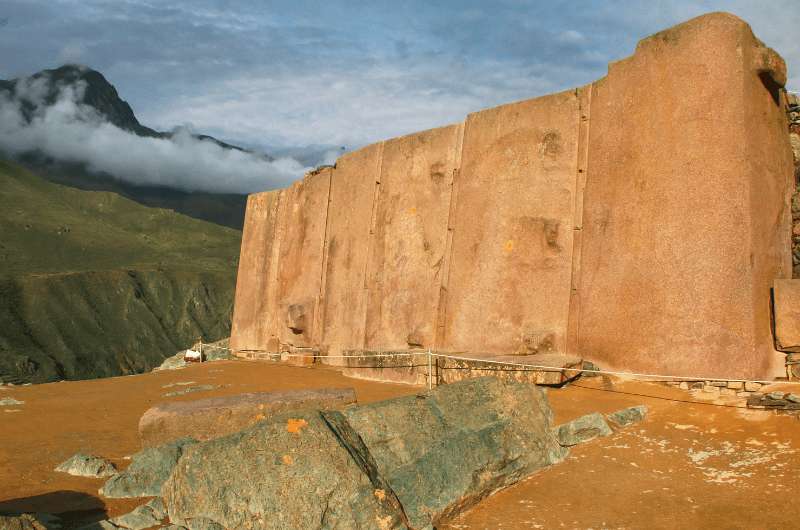
Wall of the Six Monoliths
Case in point showing the Incas’ brilliance: The stones of the Wall of the Six Monoliths, part of the Temple of the Sun, had to be moved 6 km (3.7 miles) from a quarry on a mountain on the opposite side of the river. The stones are all precisely carved and polished into another example of unbelievable Inca walls. The largest monolith is over 4 m by 2 m... how did they get it there?! Did it have something to do with Hulk, just like the huge-ass corn of Sacred Valley? Not sure how the Incas built this thing, but wow.
So, even if you feel like you’ve seen all the Inca ruins you can take, don’t miss Ollantaytambo. Just check out the photos! Real life is like a thousand times better.
Be prepared for walking up and down a lot of stairs at Ollantaytambo ruins. It’ll be worth it, but you’ll be huffing and puffing. It can all be over in 2 hours, after which you can check Ollantaytambo off your to-do list and head down to town for a coffee.
Tip: Read about the super mysterious Vilcabamba ruins if you want to find the lost city in the middle of the jungle. And get up to speed on Inca history in our About Peru article.
4. How to visit Ollantaytambo, Peru? Give it as much time as you have!
Visiting Ollantaytambo is a breeze, and it’s a must, whether you’re planning a dedicated day trip or just passing through for a couple of hours. It’s the main station for trains to Aguas Calientes and Machu Picchu, so you’ll likely stop here. Make sure to spend at least part of a day in Ollantaytambo, because once you see what you’d be missing, your FOMO will act up intensely.
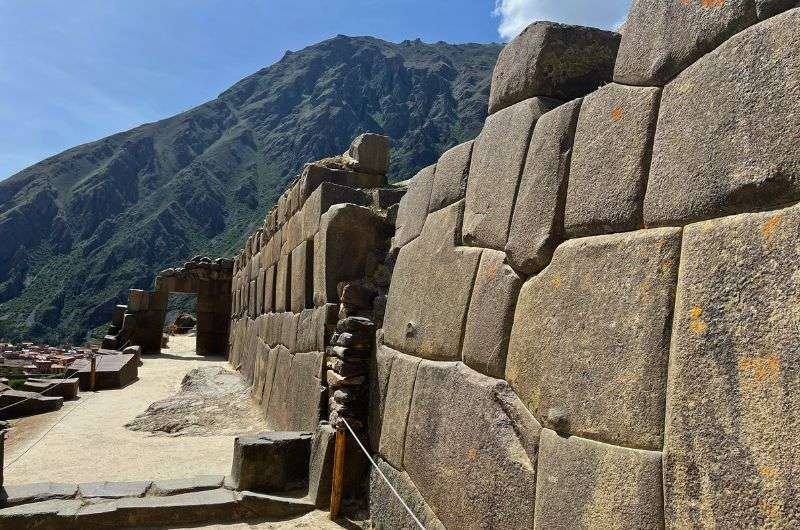
These Inca walls in Ollantaytambo are hard to comprehend
If you’re short on time, you can combine Ollantaytambo with other Sacred Valley highlights (Pisac, Chinchero, Moray, and Maras) in one day from Cusco.
But, if possible, stay overnight before your Machu Picchu train. You can drive from Cusco by renting a car like we did or take PeruRail/Inca Rail from Cusco or Urubamba. Then again, if you take the train, you’re probably missing all the stops between Cusco and Ollantaytambo, and that’s a real shame!

5. How do you get to Ollantaytambo in the Sacred Valley?
Most people visit Ollantaytambo from Cusco. You can drive, take the train, a taxi, or even a bus. We drove in our rental car and it’s obviously the best option, because then you’re free to stop wherever you like on the way.
Driving from Cusco to Ollantaytambo
Ollantaytambo is 50–60 km (31–37 miles) from Cusco depending on which route you take. The drive takes about 1.5 hours if you’re traveling on the longer but more comfortable road through Huarocondo, though we know for a fact you will be wanting to make stops on your way through Sacred Valley. That means you will be taking the uncomfortable, dusty road through the highlights of Sacred Valley like Chinchero village and the Maras salt terraces.
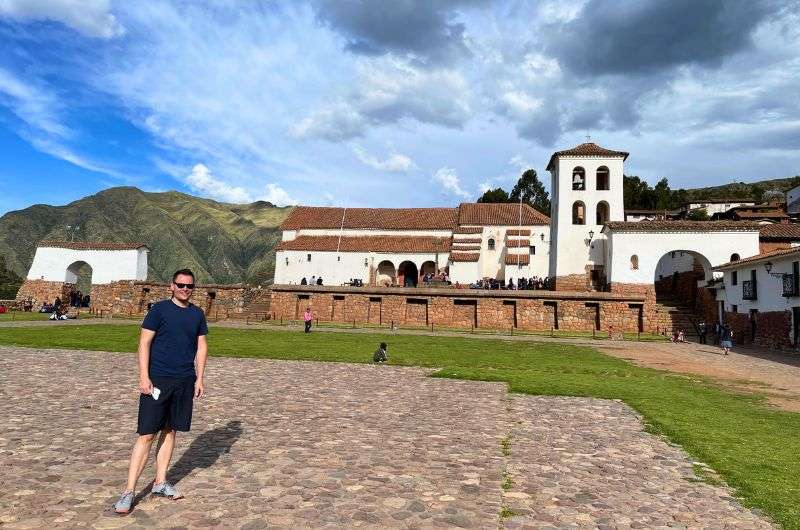
Chinchero village is one of the places you can stop on your way to Ollantaytambo

Taxi from Cusco to Ollantaytambo
If you don’t have your own set of wheels and you hate the bus like us, a taxi is the way to go. The journey will set you back USD 50 going point-to-point, more if you negotiate some stops on the way and how long the driver will spend with you in total.
Pro tip: If you aren’t spending the night in Ollantaytambo, whatever you do, make sure your driver waits for you and doesn’t just drop you off and leave!
Train from Cusco to Ollantaytambo
To catch a train from Cusco to Ollantaytambo, your options are PeruRail and Inca Rail, both offering regular departures. The train journey from Poroy or San Pedro station in Cusco takes about 1.5 to 2 hours. Make sure to book your tickets in advance, especially during peak tourist seasons, as trains fill up quickly. Both operators offer comfortable services with scenic views along the way!
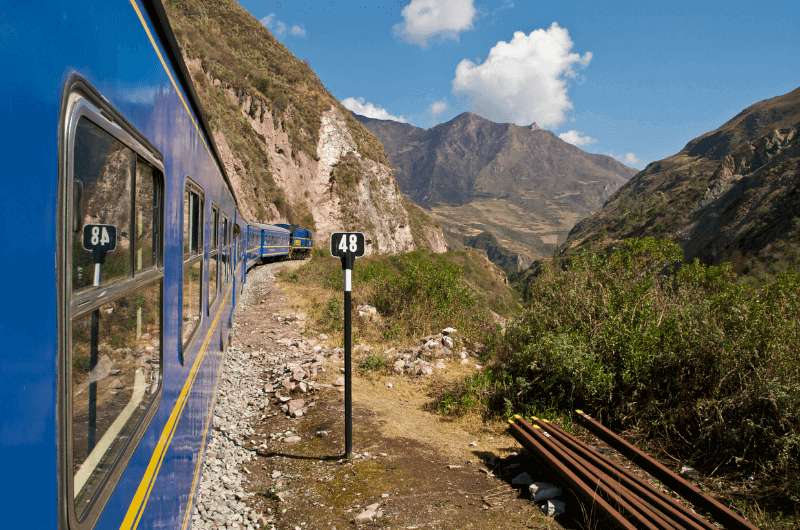
Don’t forget to book your tickets in advance!
If you're already in the Sacred Valley, there’s also a train from Urubamba to Ollantaytambo, which is shorter.
6. Where is the Ollantaytambo train station?
Despite the ruins and views being awesome, the most visited place in town is the Ollantaytambo train station. That’s because it’s where hundreds of tourists alight the numerous daily trains to Aguas Calientes (Machu Picchu Pueblo), which is the entry point to Machu Picchu itself.
Tip: We wrote up a whole big, fat article about the logistics of getting to and into Machu Picchu (because it is a doozy!), so check that out if that’s your next stop. You can also check out this article about the best time to visit Machu Picchu. We went in rainy season…was it a good idea?? Find out in the article.
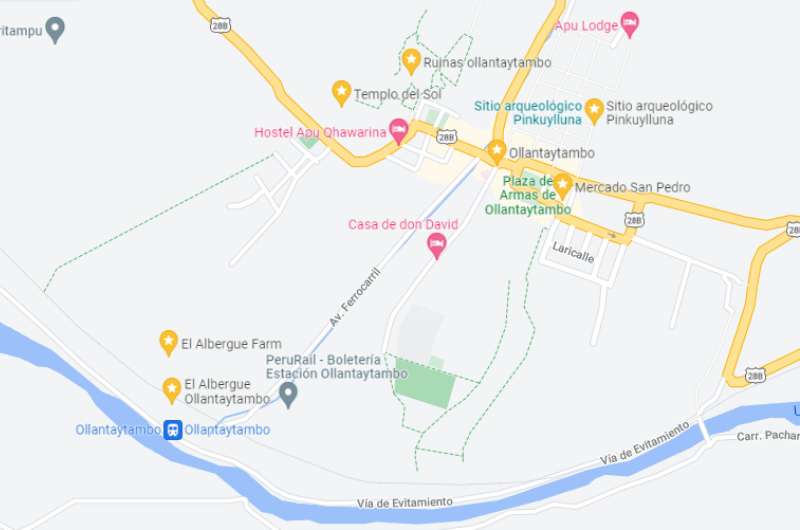
The location of the Ollantaytambo train station—right by the Urubamba River, 1 km away from tow
Ollantaytambo train station doesn’t disappoint, so even though you’re in a tiny town in the middle of the mountains, everything at the train station is well organized. Even the bathrooms are clean. There are also places to by snacks and some (bad) coffee.
The train station is located down by the river, about 1 km (0.6 miles) away from the center of Ollantaytambo town, right along the Urubamba River.
You can park at the train station at Ollantaytambo for PEN 15 (USD 4) per day.
7. Stay in a hotel close to Ollantaytambo train station for convenience
I’m going out on a limb here and guessing that if you’re staying overnight in Ollantaytambo, you’re either heading to or coming back from Machu Picchu. That’s why being right by the train station comes in handy, and you can’t get any closer than the El Albergue Ollantaytambo.
This hotel is below my usual preferred rating of at least 4 stars, but it has large, clean rooms with nice decor, has location going for it, and the owners are lovely. (Though you’ll be surprised by how expensive 3-star accommodation can get in this town!)
The rooms are basic but very clean and even charming, with high ceilings and wooden beams. If you sit out on the patio staring over the river to the snowy peaks of the mountains of Sacred Valley, you might even forget there isn’t a bathrobe waiting for you inside.
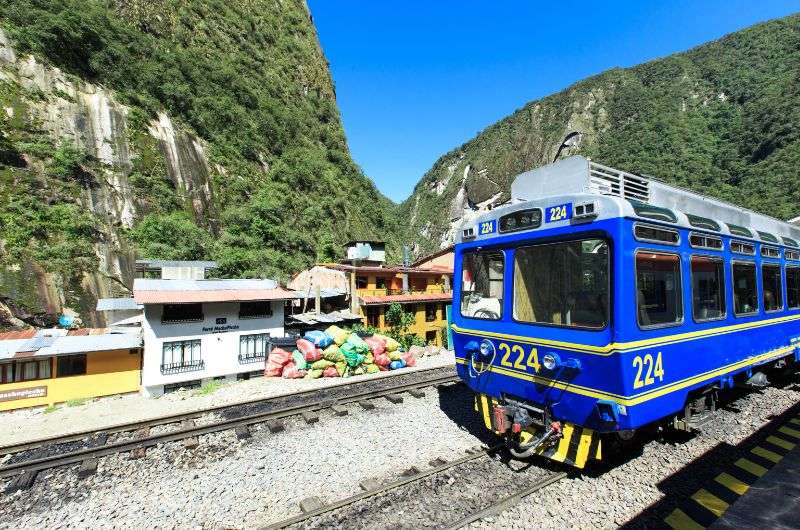
Ollantaytambo train station
Tip: The is right beside it, and that’s a gem where they grow produce for their restaurant. They even have a distillery and coffee roastery. Go on the Pachamanca Lunch Experience (book a day in advance!) to get your lunch cooked over granite rocks, buried in the ground while covered in a damp cloth. It comes out tasting like the Inca gods are looking down on you. You taste their pisco and get a pitcher of chicha, too!

8. How do I buy tickets to Ollantaytambo?
Ollantaytambo can be visited as part of the Cusco Tourist Ticket circuit 3, which costs PEN 70 (USD 18) and also includes Moray, Pisac and Chinchero, or the full Sacred Valley circuit for PEN 130 (USD 35) that includes most tourist attractions in Sacred Valley and Cusco.
See our Sacred Valley article for the details on the Cusco Tourist Ticket. Tickets can’t be bought online, so just rock up to any of the sites on the ticket you want and buy it there.
Pro tip: Take your passport with you—you’ll be asked for it when buying the Cusco Tourist Ticket. Your name will be on your ticket.
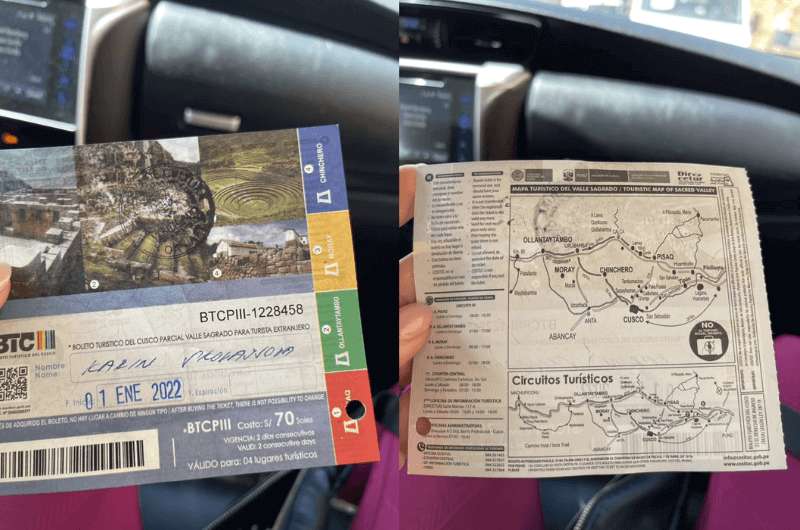
Cusco Tourist Ticket and map
9. What to do in Ollantaytambo besides visit the Inca ruins?
One of the best sort-of-secret spots to visit in Ollantaytambo is a viewpoint called Pinkuylluna. You can get the most incredible views of Ollantaytambo town, the ruins and the mountains, all in one serving. Start your climb up the steep trail by walking through a wooden door on Lares Calles. A great sunrise spot. Not so great for sunset—they close the access point before 5 pm. It’s a 30-minute climb.
The historic center of town is small and cute, inconspicuously nestled next to one of the most fascinating archaeological sites in the Sacred Valley. You’ll notice how the Patakancha River feeds into ancient irrigation channels still in use today, with water flowing down the old roads. The non-stop sound of water is a little funny, I promise you’ll be checking the sky for rain clouds at least several times. You also might end up looking for a restroom more times than you usually would.
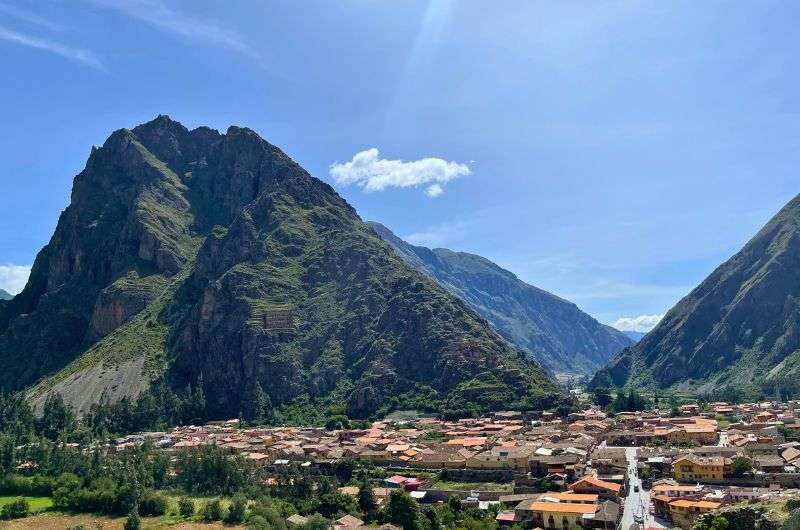
Views from Pinkuylluna viewpoint
As you explore the town, you’ll see how the Patakancha River feeds into ancient irrigation channels still in use today.
There’s a souvenir market right at the base of the ruins which offer the regular bits and bobs that you can buy everywhere else in Peru. If you want to visit a real market, visit the authentic, multilevel Mercado San Pedro right by the Plaza de Armas, the main square.
You can stock up on produce, like veggies and alpaca cheese, and make yourself a sandwich. Or, if you can’t be caught dead making your own food, there are delicious meals to try on the top floor. The vegetable and beef soup (sopa de chairo) was fantastic! Brings me back to good ol' Inca times (jk).
10. How do I take the train from Ollantaytambo to Aguas Calientes (for Machu Picchu)?
To get to Machu Picchu, you first need to get to Aguas Calientes (Machu Picchu Pueblo), a town that is not accessible by road. So, before you ask, no, there is no bus to Aguas Calientes and we couldn’t drive there as we usually would, either.
There are two companies operating the Ollantaytambo to Aguas Calientes train route: Peru Rail and Inca Rail. The trains and services are similar, so just choose based on departure time.
The trains at Ollantaytambo are well-maintained and have big windows and windows in the ceiling, allowing for a lot of gazing out at the incredible views on the way to Aguas Calientes a.k.a. Machu Picchu Pueblo.
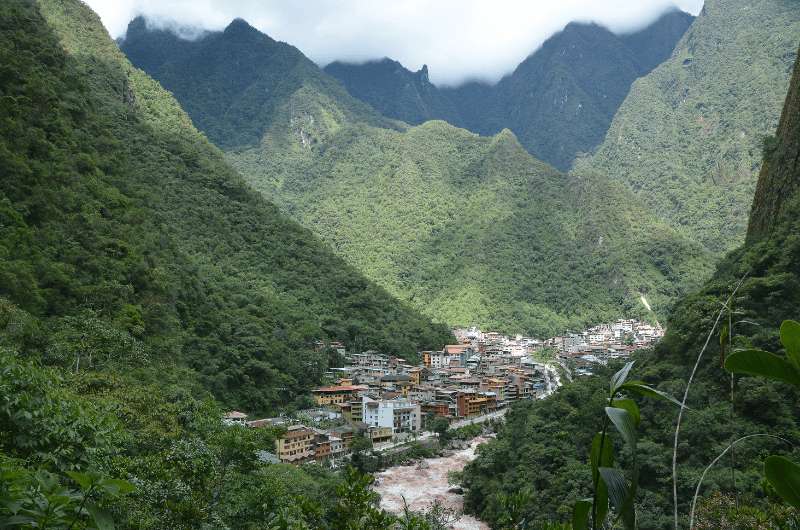
Aguas Calientes (Machu Picchu)
The views almost make up for the price: The train trip to Aguas Calientes takes 1.5 hours and costs an extortionate USD 60–100, making it one of the most expensive short train rides on the frikin planet. First service is usually around 5 am and the last train leaves Aguas Calientes around 9 pm.
Buy your train tickets online through the train companies’ websites, but not until you know which time slot your Machu Picchu tickets are going to be for. And account for time to take the bus up the mountain… I’ll once again respectfully point you in the direction of our Machu Picchu article for the best way to buy tickets for everything, because you could end up with a very bad combination of them if you don’t time things right. The guards won’t let you into Machu Picchu if you aren’t on time!
11. What is Ollantaytambo’s altitude?
With an altitude of almost 2,800 m (9,150 feet) above sea level, Ollantaytambo is up higher than Machu Picchu. Ollantaytambo’s altitude is, however, lower than Cusco, which will have you trying to catch your breath at 3,400 m (11,100 ft). You’ll be reaching for the coca tea on your first day there.
I’ve mentioned altitude sickness in almost all of my Peru articles, because wherever you are in the Andes Mountains, you’re probably way higher than your body is used to, and it’ll let you know that it’s not happy the moment you step off the plane. Make sure to stay hydrated, eat only light foods, and try to take it easy for the first day or two.

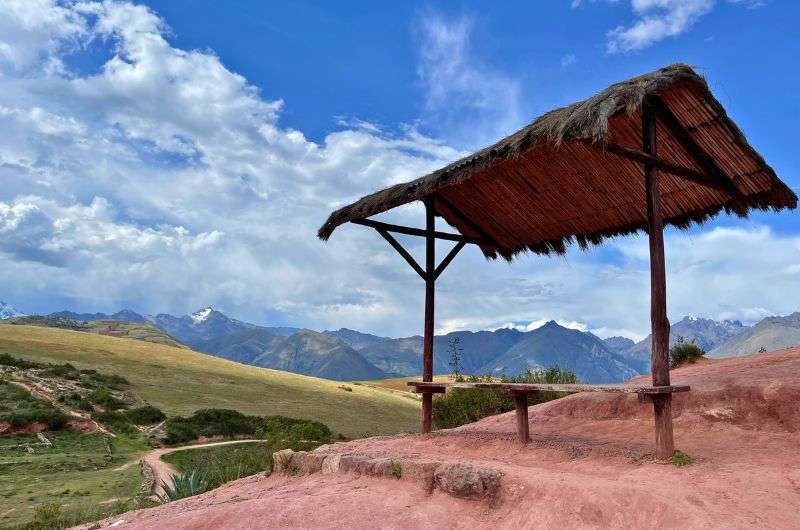
To see the Ollantaytambo temples you need to go higher than Machu Picchu!
12. The best time to visit Ollantaytambo is April to November
The best time to visit Ollantaytambo is during the dry season, April to November, when you’ll get sunshine, mild temps, and clear skies perfect for exploring and snapping photos of the ruins.
However, if you’re into lush greenery and don’t mind getting a little muddy, the rainy season (December to March) can transform the Sacred Valley into a vibrant, green wonderland—I went in January and can’t fault it. Roads might get slippery, but hey, nature photographers might love the dramatic scenery and blooming flowers. Just be prepared for a few surprise downpours!
13. Can you walk from Ollantaytambo to Aguas Calientes?
Not sure if it’s the train prices or a strong urge to make your life harder for no good reason, but there are individuals that choose to walk to Aguas Calientes instead of taking the train. This isn’t something I’d recommend, but hey, maybe you just like being different or have a fear of choo choos.
In that case, you can walk the 28 kms along the train tracks from Ollantaytambo to Aguas Calientes, which will take you the better part of the day. Read up on this option if you’re thinking about it, especially about the guards turning people away because, duh, tourists walking on the train tracks isn’t exactly what they want. Something about safety.
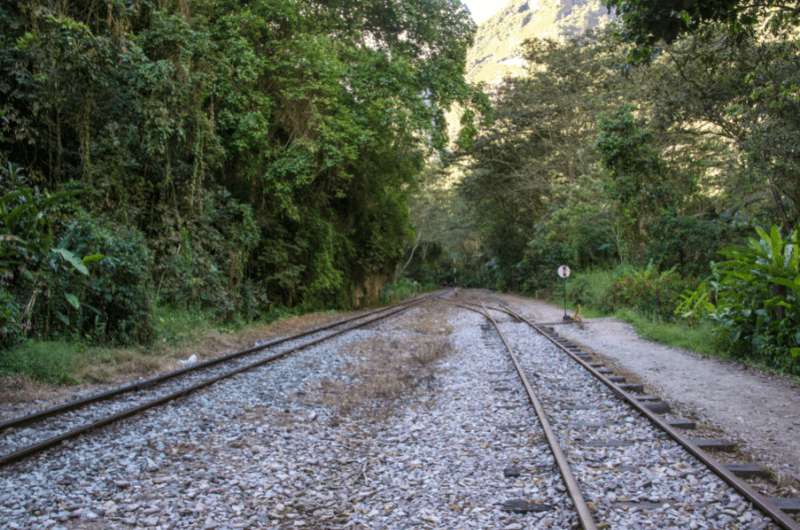
Sure, you can walk from Ollantaytambo to Aguas Calientes! It's just 28 km along the train tracks
There are also the popular multi-day treks on the famous Inca Trail (or other less crowded routes), but we didn’t consider those since we likey treks, but we no likey sleeping in tents.
14. Ollantaytambo hotels: My top picks of special places to stay in the Sacred Valley
Last time I checked (just now), there were no 4-star hotels in Ollantaytambo. For a little luxury, you’ll have to search for hotels outside of town, in and around Urubamba. The biggest selection of luxury hotels in Ollantaytambo is not in Ollantaytambo. Some of them are even hanging on the cliff face!
Sleep hanging on the side of a cliff @ Vertical Sky Luxury Suites
At the Vertical Sky Luxury Suites, you can choose to sleep in a glass pod hanging above the valley floor that you get to by walking, strapped in, mountain climbing-style, to the ledge of the mountain, before getting into your “room”. You get your own Jacuzzi up there, too. Or, you can choose the more spacious and less hanging glass dome. You still get views for days, but it provides more comfort, like an actual floor you can walk on.
For the crème de la crème that won’t trigger your acrophobia, check out the luxury hotels in Urubamba. It’s a small town about 20 km (12 miles) closer to Cusco, and even though they’re on the ground, the hotels there are top notch. Just a couple of the options we can recommend:
Experience true luxury @ Tambo del Inka
At Tambo del Inka, a Luxury Collection Resort & Spa, Valle Sagrado, you get not only luxury everything, an exceptional spa and pool, but staff are also happy to share their Inca knowledge. It’s like nothing is impossible at Tambo del Inka.
Sleep in a real Andean village (sort of) @ Rio Sagraddo
You’ll feel at one with nature at the riverside property of Rio Sagradddo, A Belmond Hotel. You can get massaged with local herbs or dine at the beautiful restaurant that serves gourmet Peruvian dishes. The Rio Sagrado resembles an Andean village. They provide organized activities such as fishing trips, horse riding and ATV tours.
You might also be interested in reading
- A Guide to Maras and Moray
- Top 9 Places to See in Sacred Valley
- A 3-Day Cusco Itinerary
- A 2-Week Peru Itinerary: A Day-By-Day Trip Plan
- The 10 Best Ruins to Visit in Peru
This post contains affiliate links. I earn a small commission if you make bookings through my links, at no additional cost to you. Thank you for your support!


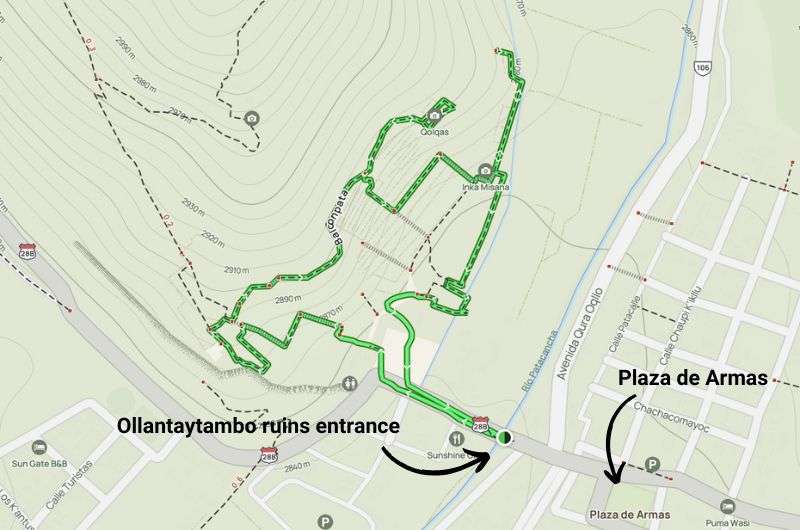
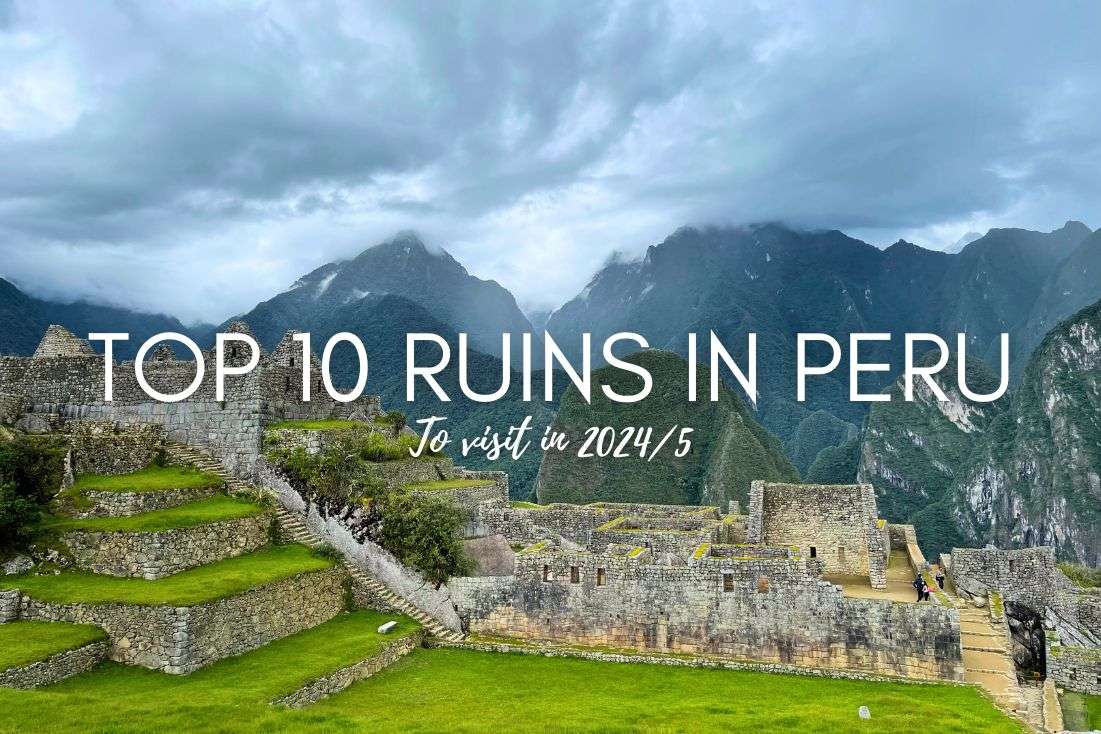
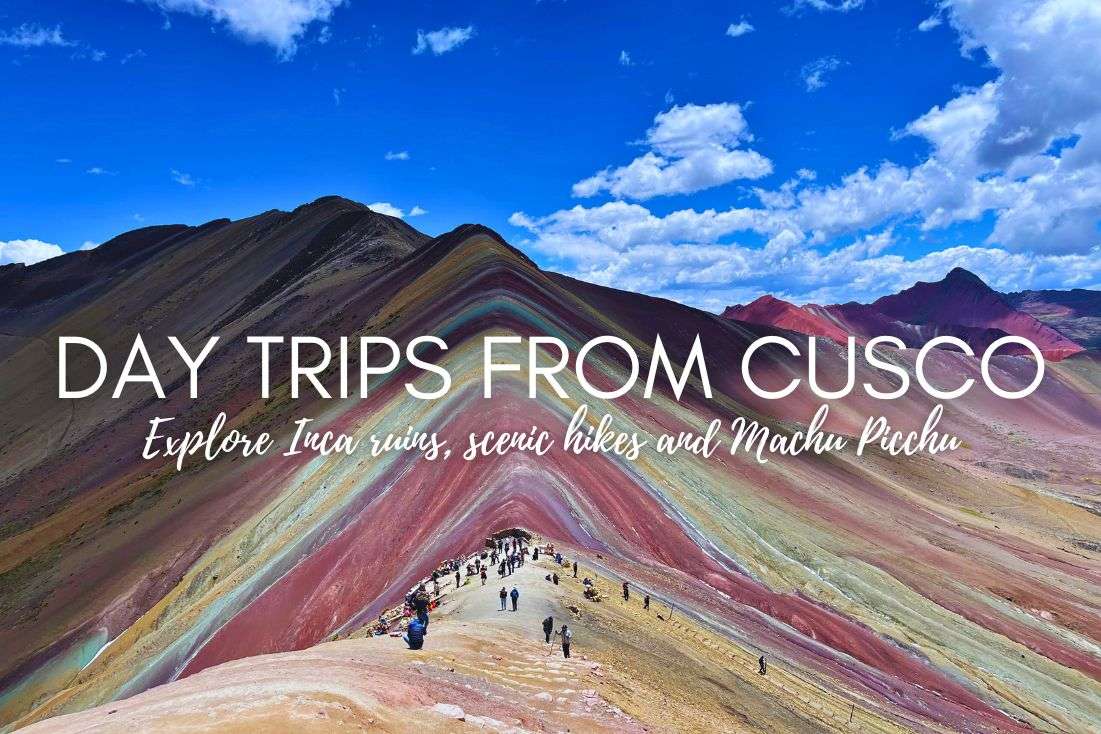
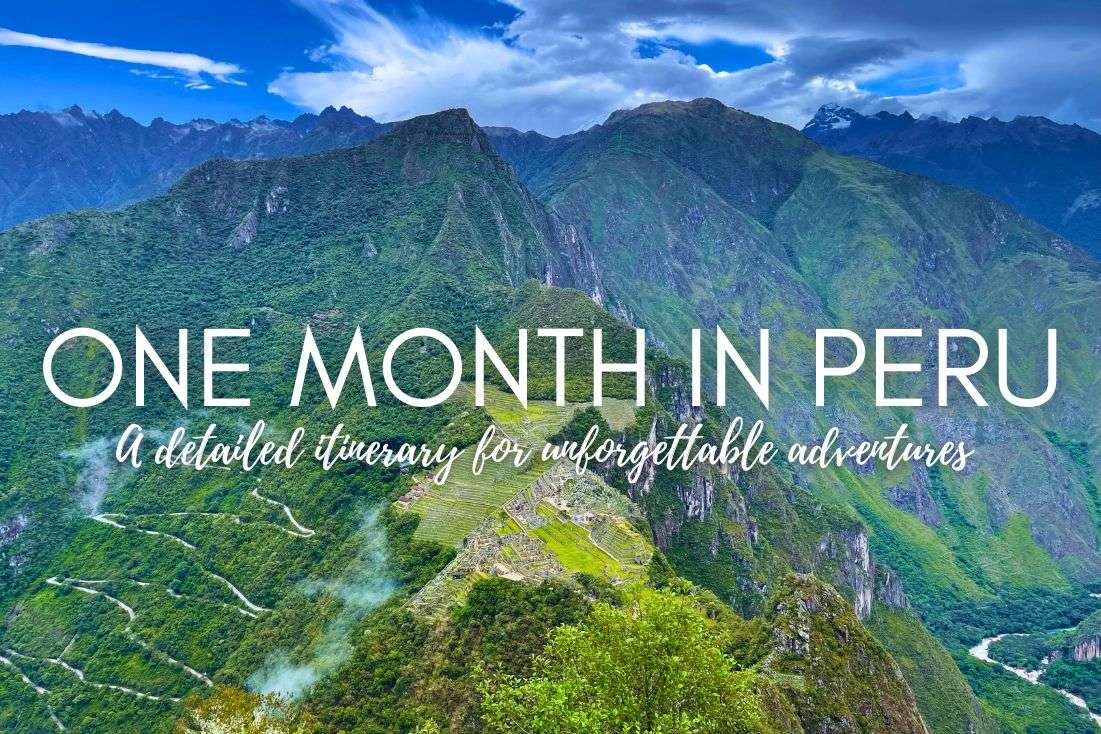





Comments | Thoughts? Give us a shout!